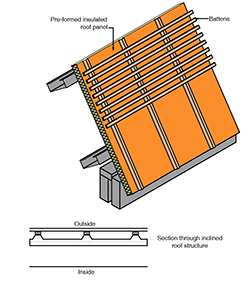Clay tiles can be put on a wide range of substructures. It would not be possible to illustrate every combination of roof structure and tile fixing method. Nevertheless, the range of examples given below should meet the needs of most new and replacement roofs.
Roof with insulation at ceiling with impermeable underlay
This is a traditional roof detail with a ventilated roof space and horizontal ceiling. Ventilation should be provided into the roof space in accordance with Building Regulation F2 and British Standard BS 5250.
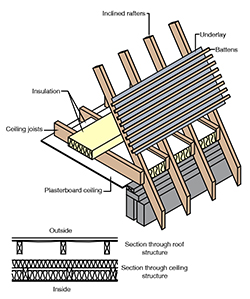
Roof with insulation at ceiling with vapour permeable underlay
This roof detail shows a horizontal ceiling and using a vapour permeable underlay without roof space ventilation.
It is recommended that there is a minimum 50mm gap between the underlay and the tiles to allow adequate air movement in the batten cavity. To provide this a minimum 25mm deep counterbatten should be fixed over the rafters.
Low and high level ventilation should be provide to the batten cavity.
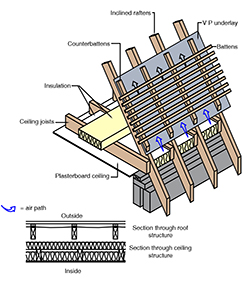
Roof structure – insulation at rafter with impermeable underlay
This detail shows a sloping ceiling and uses a non-vapour permeable underlay and is suitable where there is a room in the roof space. Insulation is fitted between the rafters.
It is recommended that there is a minimum 50mm gap between the insulation and the underlay. Counterbattens can be used to provide this gap.
A 25mm wide continuous ventilation gap is required at low level and a 5mm wide continuous ventilation gap is required at high level.
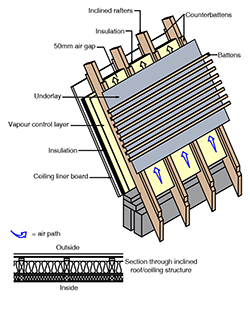
Roof structure – insulation at rafter with vapour permeable underlay (V1)
This detail shows a sloping ceiling and uses a vapour permeable underlay without roof space ventilation and is suitable where there is a room in the roof space. Insulation is fitted between the rafters.
It is recommended that there is a minimum 50mm gap between the underlay and the tiles to allow adequate air movement in the batten cavity. To provide this a minimum 25mm deep counterbatten should be fixed over the rafters.
A 25mm wide continuous ventilation gap is required at low level and a 5mm wide continuous ventilation gap is required at high level. Counterbattens are used between the rafters and plasterboard to reduce the number of perforations through the vapour control layer.
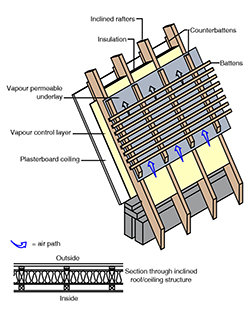
Roof structure – insulation at rafter with vapour permeable underlay (V2)
This detail shows a sloping ceiling and uses a vapour permeable underlay without roof space ventilation and is suitable where there is a room in the roof space. Insulation is fitted between the rafters.
It is recommended that there is a minimum 50mm gap between the underlay and the tiles to allow adequate air movement in the batten cavity. To provide this a minimum 25mm deep counterbatten should be fixed over the rafters.
A 25mm wide continuous ventilation gap is required at low level and a 5mm wide continuous ventilation gap is required is required at high level. This is a variation on detail (5) incorporating an additional layer of insulation between the rafters and ceiling.

Roof Structure – insulated liner tray system
This detail shows the use of a metal liner tray system fixed to horizontal steel purlins. Rigid insulation is positioned between the upstands of the liner tray.
Permeable underlay is laid over the upstands and counterbattens are secured to the upstands using proprietary fixings as recommended by the liner tray manufacturer. Tile battens are then nailed to the counterbattens in the usual way.
A suspended ceiling system is used (not shown).
(Advice should be sought from the liner tray
manufacturer)
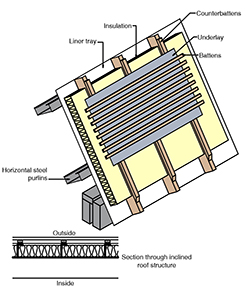
Roof Structure – Pre-formed insulated liner tray system
This detail shows the use of a metal pre-formed liner tray system with insulation ‘sandwiched’ between lower and upper metal panels. The system is fixed to horizontal steel purlins. Tile battens are secured directly to the panel using proprietary fixings as recommended by the liner tray manufacturer
A suspended ceiling system is used (not shown).
(Advice should be sought from the liner tray manufacturer)
